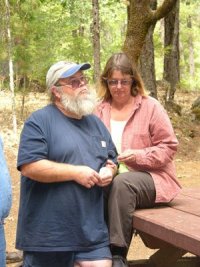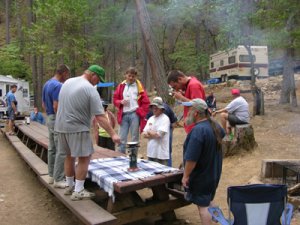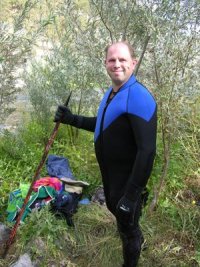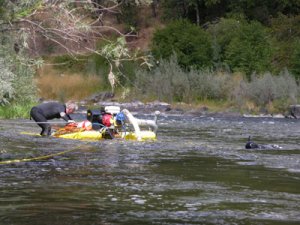By Dave McCracken
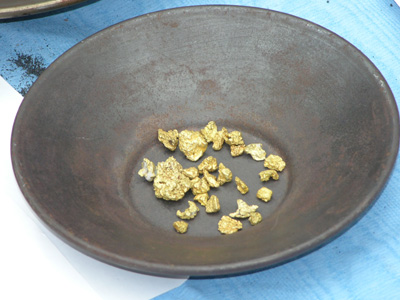
This Group Dredging Project took place towards the lower end of the Club’s K-11 claim (Hwy-96 mile marker 63.58) along the Klamath River, not far upriver from Schutt’s Gulch. This is located about 3 miles upriver from where Highway 96 crosses Seiad Creek, near the small town of Seiad.
We conducted another Group Dredging Project towards the upper-end of this claim earlier in the season and did pretty well. K-11 is a very productive section of river, both for dredging and surface-sluicing activity on the far side of the river. The claim is quite long; and despite lots of successful activity, I don’t believe that most of the area has even been adequately sampled yet.
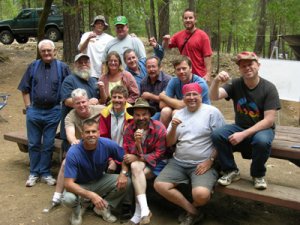
I have had my eye on the lower-end of K-11 since all the way back to 1997, when founding Club member, Tony Steury, was dredging there with a 5-inch dredge, consistently recovering an ounce of gold per day. I was buying his gold, so I knew he was getting it. And because of that, I made a special visit to Tony’s dredging site one day, and even swam down into his excavation to get a first-hand look. Tony was dredging towards the road-side edge of the river, pretty near to the lower-end of K-11.
To my knowledge, no-one ever returned to the area where Tony was dredging to pick up what he might have missed. Tony’s gold was all flakes and fines. It was a lot of gold for the amount of material he was processing through his 5-inch dredge.
Over the years, I have swam down through the lower-end of K-11 with lots of different members who were participating in various group events, and I have always encouraged members to go back there and search for the gold Tony left behind. Tony only dredged in there for a few weeks, so he could not have cleaned the area out. But I have never seen anyone go back there.
That’s the thing about the The New 49’ers; we have so many available options, it takes a long time to get around to all of them!
Anyway, “Tony’s lost gold” was one of the primary targets we were considering for this Group Project. I figured we could find it with an organized group using 3 dredges to sample around the target area. So, a few days before this Group Project, Craig Colt and I were down standing along the edge of the river at Schutts Gulch, taking a hard look at the speed and depth of the water, access points, parking, camping and other things that are important to these Group Projects.
Group Projects require at least a few slow, shallow areas where we can work with less experienced miners.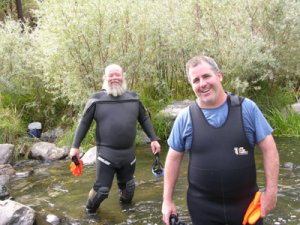 Projects sometimes require more parking than would normally be needed. They require the access to not be too difficult. These are all things we have to think about in advance. Because we don’t know everyone who will be on a Group Project until everyone shows up on Saturday morning, we have to plan for members that might not be up for difficult situations.
Projects sometimes require more parking than would normally be needed. They require the access to not be too difficult. These are all things we have to think about in advance. Because we don’t know everyone who will be on a Group Project until everyone shows up on Saturday morning, we have to plan for members that might not be up for difficult situations.
Craig and I spent most of a day comparing the lower-end of K-11 to another very promising-looking area towards the lower-end of K-9. Here is another area where few members have gone, and where the dredging prospects look fantastic! No question that we will do a Group Dredging Project on K-9 in the near future.
Anyway, after spending the better part of a day weighing and balancing the two areas, Craig and I decided we would do this Group Project at K-9. It really looked the best for what we wanted to do.
But on our way back to Happy Camp, we saw a 5-inch dredge floating out on the river towards the lower-end of K-11; perhaps 100-yards upstream of where Tony Steury made his big strike. So we stopped to talk with the member, Bruce Johnson, who was dredging there. He showed us his gold, which consisted of plenty of fines and flakes, with some nice, crystalline nuggets. Wow!
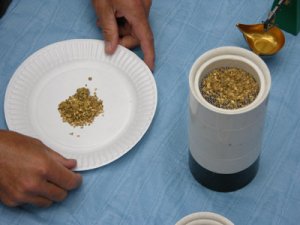
Bruce told us he was getting his gold from around some larger rocks in a hard-packed layer around three feet into the material. The water was only about 6-feet deep out where Bruce was dredging. Bruce told us emphatically that he did not have any problem with the Group Project moving in around him, since he was about to finish his season, anyway. In fact, he said he would welcome the company.
So Craig and I immediately did the smart thing; we asked Bruce if we could operate his dredge for an hour or so, allowing him to keep any gold that we found. With no hesitation, Bruce agreed to allow us the use of his dredge. So Craig and I jumped right into his hole and started dredging without any further delay.
There is an important lesson in this: The New 49’ers is a highly-active mining association, with very expansive property reserves. The choices of where to go are endless. For better success, it is important to narrow the choices to the best-possible prospects any way you can. The most effective way I know to do this, is to get right down inside of an active mining excavation that is recovering high-grade gold. Then you can see for yourself what the streambed layers look like, and where the gold is coming from. It doesn’t get any better than that!
Members often ask me how I am able to readily locate high-grade pay-streaks on New 49’er claims. There is no secret to this. I pay attention to every strike that is made on our claims. Whenever possible, when there is a new strike, I go right down and look at where the gold is coming from, what streambed layers are involved, how wide the pay-streak is, how much volume is being processed, and how the deposit lines out in the waterway. These are things that I never forget!
My memory is poor on some things. But I never forget the details of where someone finds gold! Because I know I can always go back to those same areas with a sampling team and pick up where the earlier miners left off – either at one end of the pay-streak, or a little further up or downstream, where the next pay-streak is located.
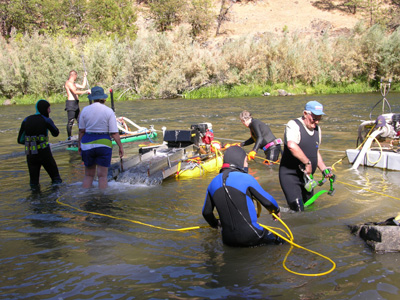
The nice thing about a Group Project is that I can direct a dozen or so people, using several dredges, in a very-organized sampling program that is targeted to re-establish a gold-line that has already been found before. 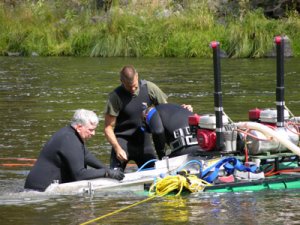
So when Bruce offered to allow Craig and I to use his dredge to have a look at a pay-streak he was actively mining, we wasted no time getting into the water. Bruce told us that most of his gold was coming from the contact zone on top of a really hard-packed grey layer down about three feet into the streambed material. He said he could see the gold sitting right on top of the grey layer. It didn’t take but about 15 minutes for Craig and I to work a top-cut (reaching out and working about 4 or 5-square feet of material off the front of Bruce’s dredge hole) down to the grey layer. Sure enough, we saw the pieces of gold sitting right on top of the grey material. That’s all we needed to see!
The wonderful thing about our mining group is that we have so many really nice people associated with us as active members. Miners helping miners! I cannot tell you how lucky Craig and I felt when Bruce invited us to bring the Group Dredging Project into the area where he was actively dredging up a high-grade gold
deposit! 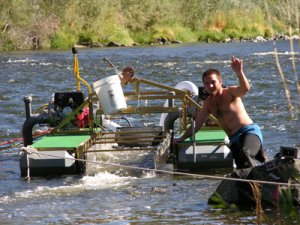
Here’s my secret to finding gold: When someone offers you a sure thing, take it!
So Craig and I quickly altered our plans to manage this Group Project at the lower-end of K-11 near Schutt’s Gulch. Fortunately, the Forest Service has a very nice developed campground at O’Neil Creek (Hwy 96 mile marker 65.50), about a mile upriver from where we were going to be doing the Project. We made arrangements to rent the group camping site for a week, so participants would have a comfortable, quiet place to camp.
This Group Project involved 12 participants (11 men and 1 woman), plus my two very-experienced helpers, Craig Colt and Ernie Kroo and myself; 15 of us in all.
Several of the participants were dredging for the first time ever, and several others had little previous experience under the water. One of the primary objectives of these projects is to help all participants achieve personal confidence while dredging underwater. We take this responsibility very serious. The nice thing about this Project was that since we already pretty-much knew where the gold was, I was going to be able to put 100% of my own focus into helping others dial in, to what we needed to do. 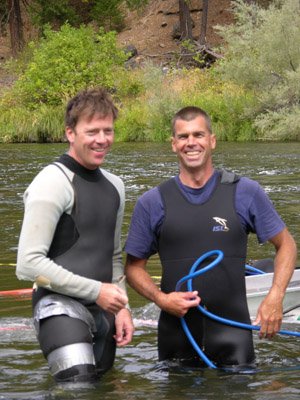
Most of us camped in the Forest Service O’Neil campground for duration of the project. So, we were also able to spend some very pleasant after-hour time visiting and enjoying our moments together during this adventure. Ernie Kroo is one of the best guys on a BBQ-pit that I have ever seen, and he takes great pleasure in making sure everyone eats well on these Projects. The food was great!
All of the participants in this Project arrived full of motivated-enthusiasm. When Craig and I walked everyone down on the first morning to show them where the gold had already been located, it was everything we could do to slow things down enough to keep track of the activity. I have to say, this was the fastest I have ever seen three dredges put into the water and set up. People were actually running with the loads! Usually, I am happy if we just get camp set up and the dredges in the water on the first day. But this was all done before lunch on the first day of this Project!
So with just a little discussion, we turned three separate teams loose on Saturday afternoon in an organized sampling plan. One dredge was placed around 60 feet in front of where Bruce was dredging, directly in line with him. Another dredge was placed around 60 feet downstream and directly in line with where Bruce was getting his gold. And the third dredge was sent about 100 yards downstream in an effort to find “Tony Steury’s lost gold.”
This type of gold mining (dredging) is not rocket science. Since Bruce was getting good gold, we were nearly certain that if we got directly in line with him in the river, and dredged down to the very same layer, that we would get gold, too. We proved this theory correct by the end of the first day. While our upstream dredge was already producing fines and nice-sized golden flakes, the downstream dredge started producing nice big corn-flake-sized crystalline gold nuggets. 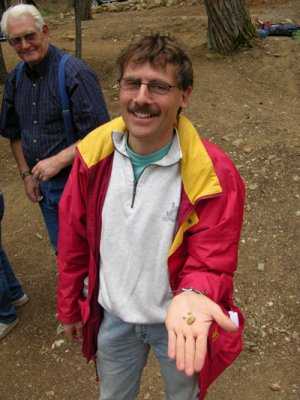
I just cannot tell you how excited everyone was! I was sitting back thanking my lucky stars for how easy the week was going to be for me. Incredible!
These Group Dredging Projects are usually very challenging for me. While there are many things we have to make happen during the week, they all basically add up to three very important things: (1) we have to help all the participants get dialed in to what we want to accomplish, with no-one getting injured. (2) We have to locate a high-grade gold deposit. (3) We need to develop the gold deposit in such a way as to recover as much gold as we can during the remaining time allowed to us.
While the other things are incredibly important, I can tell you from plenty of experience that it is the recovery of lots of gold that carries the emotional tone of the group during the project. Every gold deposit is different, and therefore causes different types of feelings. This deposit was full of beautiful, crystalline nuggets that were being picked out of the dredges after every dive – and sometimes even while the dives were happening. All week long, people were rejoicing in their excitement about the nuggets we were recovering. What a week!
All of the important choices and decisions are discussed during these Group Projects. This is part of the experience. Because, just like the fork in the road when you only have enough time to go in one direction, every main choice during any gold prospecting expedition will affect how things come out in the end. While we have narrowed the choices down to just a few by the time we begin one of these Projects by choosing the section of river, we still must decide where we will do our sample holes, and how much time we will devote to each sample.
There are never any fixed answers to these choices. There is an emotional and intellectual chemistry involved where the results of samples are compared to each other, measured against the prior information we have about the area, and balanced against how much time we have. Seldom is there a fixed right-or-wrong answer. You just do the best you can and push forward. We always try and get all of the participants directly involved with this chemistry; because this is the risk-taking adventure-side of prospecting that turns to an incredible feeling of wonder and excitement, and a fantastic feeling of team-work accomplishment, when high-grade gold is recovered.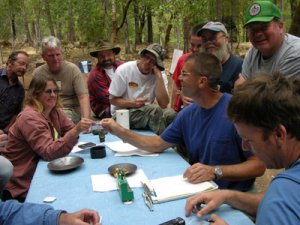
Having seen Tony Steury’s gold back in 1987, I knew without a doubt that his pay-streak was richer than the one we were mining near Bruce. But the question was: When there is a limited amount of time, and we are already mining a very good pay-streak further up-stream, how much of our available resources should be invested into looking for something we might not find? One of our three dredges (33% of our production-capability) was being spent looking for “Tony’s lost gold” with no luck so far. So, by mid-week, we collectively decided to move the third dredge up to the sure-pay-streak and leave the richer strike for another day.
The main challenge we faced in the established pay-streak, was that the richest gold was being recovered out of the deepest, fastest water out in the middle of the river. Although, luckily, the biggest, nicest nuggets were being recovered closer to the edge of the river, where the water was much slower. So we spent most of the remainder of the week shifting crews off and on, with everyone dredging where they were most comfortable. I think it is safe to say that everyone involved with the project was personally challenged in meaningful ways as the week played out.
In all, we recovered 5.5 ounces of gold for the week, of which 52.7 pennyweights (half the gold) were nuggets. This was, by far, the most nuggets (5 nice nuggets to each participant) we have ever recovered during a Group Project.
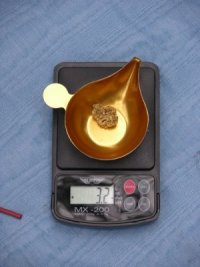
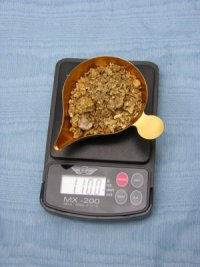
Several of the participants, along with other members of the Club, stayed around the immediate area to work out the deposit with Bruce after our project was completed.
But don’t think for a moment that this claim is worked out. We could easily devote 10 more Group Dredging Projects to sample this very long claim! The potential is fantastic!
